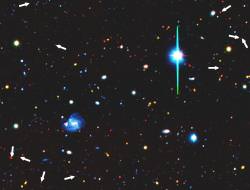Can appearances be deceiving? According to the United Kingdom Infra-Red Telescope (UKIRT), galaxies that appear old in our Universe’s early history are positioned in huge clouds of dark matter. Using the most sensitive images ever taken, UKIRT scientists believe these galaxies will evolve into the most massive yet known.
Today University of Nottingham PhD student Will Hartley is speaking to the Royal Astronomical Society’s National Astronomy Meeting in Belfast. As the leader of the study, Hartley proposes the distant galaxies identified in the UKIRT images are considered elderly from their content of old, red stars. Because these systems are nearly 10 billion light years distant, the images are as the galaxies appeared about 4 billion years after the Big Bang. Fully evolved galaxies at that point in time are hard to explain and the answer has been puzzling astronomers who study galactic formation and evolution.
Hartley and his team used the deep UKIRT images to estimate the mass of the dark matter formed in a halo surrounding the old galaxies – a halo which collapses under its own gravity to form a even distribution of matter. By measuring their ability to form galactic clusters, astronomers can get a better sense of what causes older galaxies to stick together.
Hartley explains “Luckily, even if we don’t know what dark matter is, we can understand how gravity will affect it and make it clump together. We can see that the old, red galaxies clump together far more strongly than the young, blue galaxies, so we know that their invisible dark matter halos must be more massive.
The halos of dark matter surrounding the old galaxies in the early Universe are found to be extremely massive, containing material which is one hundred thousand billion times the mass of our Sun. In the nearby Universe, halos of this size are known to contain giant elliptical galaxies, the largest galaxies known.
“This provides a direct link to the present day Universe,” says Hartley, “and tell us that these distant old galaxies must evolve into the most massive but more familiar elliptical-shaped galaxies we see around us today. Understanding how these enormous elliptical galaxies formed is one of the biggest open questions in modern astronomy and this is an important step in comprehending their history.”


“We can see that the old, red galaxies clump together far more strongly than the young, blue galaxies, so we know that their invisible dark matter halos must be more massive.”
This suggests to me that the gravity well associated with these ‘clumps’ is far deeper than that associated with the young, blue, galaxies. I wonder if the red shift caused by the deeper well has been properly accounted for. If not, then these galaxies would appear to be more distant, hence older, than they really are, would they not?
Einstein said that the larger the object, the more gravitational pull it would have. So couldn’t that explain why the older galaxies that have the larger red giant stars in them be held closer together?